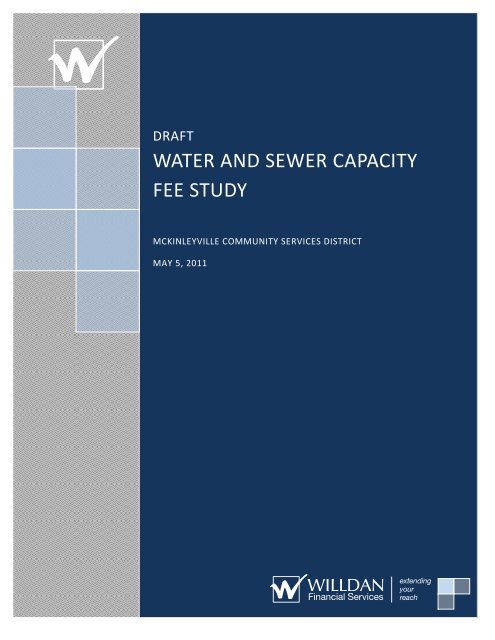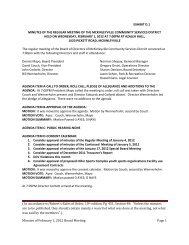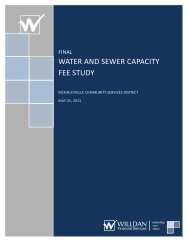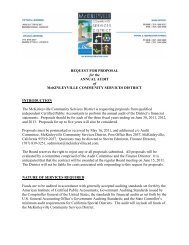water and sewer capacity fee study - McKinleyville Community ...
water and sewer capacity fee study - McKinleyville Community ...
water and sewer capacity fee study - McKinleyville Community ...
- No tags were found...
You also want an ePaper? Increase the reach of your titles
YUMPU automatically turns print PDFs into web optimized ePapers that Google loves.
DRAFTWATER AND SEWER CAPACITYFEE STUDYMCKINLEYVILLE COMMUNITY SERVICES DISTRICTMAY 5, 2011
OVERVIEW<strong>McKinleyville</strong> <strong>Community</strong> Services District (the District) retained Willdan to prepare a <strong>capacity</strong> <strong>fee</strong> <strong>study</strong> forDistrict’s <strong>water</strong> <strong>and</strong> <strong>sewer</strong> utility systems. Capacity <strong>fee</strong>s are one-time charges used to fund capital improvementsnecessary for the expansion of a utility system. The recommended <strong>capacity</strong> <strong>fee</strong>s for the District are proportionate<strong>and</strong> reasonably related to the capital facility dem<strong>and</strong>s of new development. This report documents the data,methodology, <strong>and</strong> results of the <strong>capacity</strong> <strong>fee</strong> <strong>study</strong>.The District applies two types of one-time <strong>fee</strong>s to its <strong>water</strong> <strong>and</strong> waste<strong>water</strong> system users: Capacity Fees <strong>and</strong>Connection Fees. A <strong>capacity</strong> <strong>fee</strong> is a one-time <strong>fee</strong> that is charged for new, additional, or larger connections to theDistrict’s utility system. Capacity <strong>fee</strong>s recover the costs associated with providing additional facility <strong>capacity</strong> tonew users <strong>and</strong> existing users requiring additional <strong>capacity</strong>. Connection <strong>fee</strong>s are used to recover costs associatedwith the physical installation of lateral connections to the utility system, <strong>and</strong> can be thought of as “plumbingcharges”. The scope of this <strong>study</strong> is limited to a review of the <strong>capacity</strong> <strong>fee</strong>s.It has been some time since the District last updated the current <strong>water</strong> <strong>and</strong> waste<strong>water</strong> <strong>capacity</strong> <strong>fee</strong>s in 1991 <strong>and</strong>1999 respectively. The current <strong>fee</strong>s do not adequately reflect updated system dem<strong>and</strong>s <strong>and</strong> needs for exp<strong>and</strong>edor additional facilities. In addition, several anticipated projects (Ramey Pump Station Upgrade, Murray RoadWater Tanks, Waste Water Management Facility upgrade, Mad River Bridge crossing pipeline) will improve <strong>water</strong><strong>and</strong> waste<strong>water</strong> services.EXISTING CAPACITY FEESThe District’s existing <strong>capacity</strong> charge, for both <strong>water</strong> <strong>and</strong> <strong>sewer</strong> is based on Equivalent Residential Units (ERU) <strong>and</strong>is a one-time charge determined per District Rule 1.21. An ERU is defined as any single-family residential structure.Other types of structures are evaluated by the District on an individual basis with respect to average monthlyflows, <strong>and</strong> the <strong>capacity</strong> charge imposed thereon is adjusted to be appropriately proportionate to the st<strong>and</strong>ardcharged imposed on ERUCurrent <strong>water</strong> <strong>capacity</strong> <strong>fee</strong> rates were established in 1991 at $154 per Equivalent Residential Unit (ERU). Currentwaste<strong>water</strong> <strong>capacity</strong> <strong>fee</strong> rates were established in 1999 at $1,761 per ERU. Consequently, the District’s existing<strong>water</strong> <strong>and</strong> <strong>sewer</strong> <strong>capacity</strong> charges are insufficient <strong>and</strong> do not adequately cover the costs associated with servingnew development.OBJECTIVE AND REGULATORY REQUIREMENTSThe primary objectives of establishing a full cost recovery <strong>capacity</strong> <strong>fee</strong> are to achieve equity in distributing costs<strong>and</strong> to provide a means by which new users can pay for the costs of the facilities required to serve them withoutburdening existing users.The legal requirements for enactment of development impact <strong>fee</strong> program (<strong>capacity</strong> <strong>fee</strong>s) are set forth inGovernment Code §§ 66000-66025 (the "Mitigation Fee Act"), the bulk of which were adopted as 1987’s AB 1600<strong>and</strong> thus are commonly referred to as “AB 1600 requirements.” A development impact <strong>fee</strong> is not a tax or specialassessment; by its definition, a <strong>fee</strong> is voluntary <strong>and</strong> must be reasonably related to the cost of the service providedby the local agency. If a development impact <strong>fee</strong> does not relate to the impact created by development or exceedsthe reasonable cost of providing the public service, then the <strong>fee</strong> may be declared a special tax <strong>and</strong> must then besubject to a two-thirds voter approval.MCSD | Capacity Fee Study 1
CALCULATION METHODOLOGIESAnyone of several legitimate methods may be used to calculate utility <strong>capacity</strong> <strong>fee</strong>s. The choice of a particularmethod depends primarily on the service characteristics <strong>and</strong> planning requirements for the facility type beingaddressed.Reduced to its simplest form, the process of calculating <strong>capacity</strong> <strong>fee</strong>s involves two steps: determining the cost ofdevelopment-related capital improvements, <strong>and</strong> allocating those costs equitably to various types of development.However, the calculation of <strong>capacity</strong> <strong>fee</strong>s can become complicated due to the many variables involved in definingthe relationship between development <strong>and</strong> the needs for facilities.There are three basic methods used to calculate the components of the District’s <strong>capacity</strong> <strong>fee</strong>s. Themethodologies are used to determine the best measure of dem<strong>and</strong> created by new development for eachcomponent of the <strong>capacity</strong> <strong>fee</strong>s. The methodologies can be classified as looking at the past, present, <strong>and</strong> futurecapacities of infrastructure. In instances where infrastructure has been built in advance of new development <strong>and</strong> there is excess<strong>capacity</strong> available to be utilized by new development, the buy-in methodology is utilized. Under thismethodology, new development repays the community for previous <strong>capacity</strong> investments via the<strong>capacity</strong> <strong>fee</strong>. The incremental expansion methodology is used when a community plans to provide newdevelopment the same level-of-service (LOS) that is currently being provided to existing developmentin increments. Generally, utility infrastructure does not lend itself to this methodology given itsnature of having to be in place prior to new development <strong>and</strong> <strong>capacity</strong> being constructed in largesegments. The plan-based methodology utilizes the District’s capital improvement plan (CIP) <strong>and</strong> related masterplans to determine new development’s share of planned projects. Projects that do not add <strong>capacity</strong>,such as routine maintenance or replacement of existing facilities, are not included in the <strong>fee</strong>s.Projects that add <strong>capacity</strong> are further evaluated as to the percentage of the project attributable toexisting development versus new development. Only the portion of planned projects attributable tonew development is included in the <strong>capacity</strong> <strong>fee</strong>s.Based on the available data, the majority of the facility components analyzed <strong>and</strong> incorporated into the proposed<strong>capacity</strong> <strong>fee</strong>s utilize the plan-based methodology, with the buy-in methodology used to recover costs associatedwith excess distribution <strong>and</strong> treatment <strong>capacity</strong>. A summary of the <strong>capacity</strong> <strong>fee</strong> components <strong>and</strong> methodologiesare shown in the Figure 1-2:MCSD | Capacity Fee Study 2
Figure 1-2: Capacity Fee Component MethodologyWater Capacity Fee ComponentsCalculation methodologyResourcesPlan-BasedStoragePlan-BasedDistributionPlan-BasedDistributionBuy-InPlanning <strong>and</strong> Study EffortsPlan-BasedWaste<strong>water</strong> Capacity Fee ComponentsTreatmentInterceptorsCollection linesPlanning <strong>and</strong> Study EffortsJoint Cost ComponentsWaterSewerCalculation methodologyPlan-Based & Buy-InPlan-BasedPlan-BasedPlan-BasedCalculation methodologyPlan-BasedPlan-BasedDEVELOPMENT & DEMAND DATABoth existing <strong>and</strong> planned development must be addressed as part of the analysis required to support theestablishment of <strong>capacity</strong> <strong>fee</strong>s. This section of the report organizes <strong>and</strong> correlates the information to provide aframework for the <strong>capacity</strong> <strong>fee</strong> analysis. The information in this section forms a basis for establishing levels ofservice, analyzing facility needs, <strong>and</strong> allocating capital facilities costs between existing <strong>and</strong> future development <strong>and</strong>among various customer types.Currently the District has 6,042 lateral <strong>water</strong> connections, serving approximately 5,315 active <strong>water</strong> accounts. Thedistrict has fewer <strong>sewer</strong> connections, at 4,495. As part of the Humboldt County general plan update, the Countyhas provided the District with a variety of new development projections. Based on these projections the mid-pointadditional development potential for <strong>McKinleyville</strong> CSD is approximately 1,800 development units, with maximumadditional development units of approximately 5,500. The capital improvement projects listed in this <strong>study</strong>, asdeveloped by the District, reflect the required CIP associated with the County’s mid-point developmentprojection. An adjustment to the development projections would correspondingly affect the amount of requiredCIP necessary to serve further development.A future projection of customer dem<strong>and</strong> is necessary in evaluating the <strong>capacity</strong> of the District’s current systems<strong>and</strong> analyzing plans for future <strong>capacity</strong> expansions. The District plans <strong>and</strong> sizes its utility infrastructure needsbased on all potential users <strong>and</strong> possible dem<strong>and</strong>s. Thus, the <strong>capacity</strong> <strong>fee</strong>s analysis utilizes projections of peakdaily dem<strong>and</strong>s, as these are the factors attributed to design <strong>and</strong> implementation of the utility infrastructure.MCSD | Capacity Fee Study 3
WATER CONSUMPTION CHARACTERISTICSAs the composition (single family vs. commercial) of future build-out is unknown; Willdan performed a detailedconsumption analysis which revealed that each new unit of growth is expected to dem<strong>and</strong> an average of 9.7 units,or hundred cubic <strong>fee</strong>t (HCF), per month, based on historical averages. As a result, the forecasted 1,800development units will generate an annual <strong>water</strong> dem<strong>and</strong> of nearly 185,000 HCF. A 30% increase in consumptionfrom current levels.Figure 1-3: Water Connection <strong>and</strong> Consumption ProjectionsExisting GrowthProjectedBuild-outTotal Annual Consumption (hcf) 619,326 209,744 829,070Total Potable Water Active Connections 5,315 1,800 7,115Consumption per Connection (hcf) 116.5 116.5 116.5Monthly Consumption per Connection (hcf) 9.7 9.7 9.7SEWER DISCHARGE CHARACTERISTICSSimilarly, Willdan applied, <strong>and</strong> confirmed the validity of, industry st<strong>and</strong>ard discharge factors to determine theamount of <strong>water</strong> being discharge to the <strong>sewer</strong> system. As <strong>sewer</strong> discharge is not metered, it is necessary to applya discharge factor to account for <strong>water</strong> used for irrigation – Industry st<strong>and</strong>ards, dictate that Single FamilyResidential units discharge approximately 70% of <strong>water</strong> use, while all other customer classes dischargeapproximately 90% of <strong>water</strong> consumption. The discharge-weighted average for the entire system was determinedto be 76%. These figures were reconciled against the District’s treatment records to confirm the appropriateapplication of industry st<strong>and</strong>ards.With the discharge factors applied, average monthly discharge is 7.4 HCF per account. Consequently, theforecasted 1,800 units will generate an annual <strong>sewer</strong> discharge of 159,405 HCF annually, a 34% increase indischarge from current levels.Figure 1-4: Sewer Discharge Factor ProjectionsExisting GrowthProjectedBuild-outTotal Annual Consumption (hcf) 619,326 209,744 829,070Total Potable Water Active Connections 5,315 1,800 7,115Consumption per Connection (hcf) 116.5 116.5 116.5Monthly Consumption per Connection (hcf) 9.7 9.7 9.7Discharge Factor 76% 76% 76%Total Annual Discharge (hcf) 470,688 159,405 630,093Monthly Discharge per Connection(hcf) 7.4 7.4 7.4MCSD | Capacity Fee Study 4
WATER CAPACITY FEESFigure 2-1 below lists <strong>water</strong> related CIP items. Capacity <strong>fee</strong>s can only recover costs directly attributable to newdevelopment. Accordingly, with the assistance of Willdan, District staff reviewed CIP projects, project by project<strong>and</strong> determined a percent of the project total cost that is directly related to new development. The portions ofproject costs not attributable to growth are then allocated to existing users as part of the monthly <strong>water</strong> rates.The CIP presented below represents the capital projects necessary to meet the dem<strong>and</strong>s of projected growth.Additionally, as the list includes CIP projects that are to be completed over the next ten years (through June 30,2021), all CIP projects have had an annual inflation factor (the Engineering News Record Construction Index)applied so that the cost in the year of projected completion best approximates then-current costs.Figure 2-1: Water System Capital Improvement Program AllocationWater SystemTotal Cost(Inflated)% Attributed toGrowth(Inflated $)Attributed toGrowth ComponentMurray Road Tank 3,710,745 15% 556,612 StorageEmergency Water Line River Crossing 792,886 30% 237,866 DistributionWater Tank Upgrade 1,109,391 30% 332,817 StorageRamey Pump Upgrades 1,105,210 80% 884,168 DistributionEmergency Water Supply 300,331 50% 150,166 DistributionRadio Telemetry Upgrade (Water) 126,521 0% - N/AMeter Reader Upgrade 46,594 0% - N/AGenerator Testing 11,869 25% 2,967 DistributionMcCluski Tank 3A Roof Upgrade 5,657 0% - N/ATank Seismic Actuators - 0% - N/AFire Hydrant System Upgrade 100,761 50% 50,380 DistributionWater Main Rehabilitation <strong>and</strong> Replacement 2,311,497 25% 577,874 DistributionMeter Replacements 1,497,333 0% - N/ATotal Water 11,118,795 2,792,850WATER STORAGEThe District plans to spend $4,820,136 on the Murray Road <strong>water</strong> storage tank over the next ten years. Of which,fifteen percent or $889,429 of the cost/need is attributable to new growth. A new 3-million gallon tanks isplanned for construction on the District’s Murray Road site. The new tank at that location would increase theDistrict's storage <strong>capacity</strong>, enhance fire flows during peak summer usage <strong>and</strong> provide additional system <strong>capacity</strong>for new growth, especially in northern <strong>McKinleyville</strong>. Staff has determined it would be advantageous to initiatephased construction of two tanks at this location in order to spread the cost over a longer period, <strong>and</strong> to enhancethe operational flexibility of the system by having two tanks to allow for maintenance <strong>and</strong> redundancy.MCSD | Capacity Fee Study 5
Figure 2-2: Water Storage Projects Allocated to New GrowthWater System Total Cost Cost Allocated to GrowthMurray Road Tank 3,710,745 556,612Water Tank Upgrade 1,109,391 332,817Total Water 4,820,136 889,429Ten Year TotalGallons of Capacity per Day889,429450,000Cost Per Gallon $1.98WATER DISTRIBUTIONThe District purchases all of its <strong>water</strong> from Humboldt Bay Municipal Water District. Water is pumped fromHBMWD's facility on the Mad River to the Ramey Pump Station. Water is then pumped to MCSD's six storagetanks where it is gravity fed to MCSD's customers.Given the ability for new development to utilize excess distribution <strong>capacity</strong>, the buy-in methodology is used tocalculate the portion of the proposed Water Capacity Fee attributable to distribution facility costs.In order to determine the appropriate buy-in charge, the total cost of the existing plants assets were reviewed.The records revealed the original cost of the District’s utility system was $10.1 million, $8.8 million less Grantfunded <strong>and</strong> Developer contributed capital. This cost ($8,859,436) was divided by the distribution <strong>capacity</strong> of theexisting infrastructure (5,250,000 gallons per day) yielding a buy-in cost of $1.69 per gallon.In addition, the District is planning on six <strong>water</strong> distribution projects over the next ten years. Discussions withDistrict staff indicate that these projects will provide sufficient <strong>capacity</strong> for forecasted mid-point build-out. Basedon projections of peak <strong>water</strong> dem<strong>and</strong> from new development, new development over this period is projected toplace a dem<strong>and</strong> of 689,936 gallons daily (Average Daily Use * Peak * Number of Accounts).Additionally, allocated to <strong>water</strong> distribution are costs related to securing <strong>and</strong> constructing an emergency <strong>water</strong>supply. Although currently deficient, the proposed emergency <strong>water</strong> supply is being sized to accommodateexisting <strong>and</strong> future growth. As such, the cost of the project is being split equally between existing <strong>and</strong> future users.Figure 2-3: Water Distribution Projects Allocated to New GrowthWater System Total Cost Cost Allocated to GrowthEmergency Water Line River Crossing 792,886 237,866Ramey Pump Upgrades 1,105,210 884,168Emergency Water Supply 300,331 150,166Generator Testing 11,869 2,967Fire Hydrant System Upgrade 100,761 50,380Water Main Rehabilitation <strong>and</strong> Replacement 2,311,497 577,874Total Water 4,622,554 1,903,421Ten Year Total1,903,421Gallons of Capacity per Day689,936Cost Per Gallon $2.76MCSD | Capacity Fee Study 6
JOINT COSTSTo ensure adequately supply <strong>water</strong> <strong>and</strong> <strong>sewer</strong> for new development, the District also needs non-<strong>capacity</strong> itemssuch as administrative building space. These costs are allocated to cost per connection, since connections are thebest proxy for estimating dem<strong>and</strong>. These costs reflect the additional dem<strong>and</strong> on administrative <strong>and</strong> overheadcosts associated with an increased service population. Joint costs total $2,426,683 with new growth beingallocated $681,621. As these are joint costs between the two services, costs were halved, with each beingapportioned $340,810. As shown in Figure 2-4, the cost per new account for the joint costs is $189.34.Figure 2-4: Joint Cost Capital Improvement Program AllocationJoint SystemGrowth's Cost%Attributedto GrowthCostAllocatedto Growth% toWaterCost toWater% toSewerCost toSewerBackhoe 80,025 20% 16,005 50% 8,002 50% 8,002Dump Truck 126,003 20% 25,201 50% 12,600 50% 12,600Tractor <strong>and</strong> Attachments 150,194 20% 30,039 50% 15,019 50% 15,019Air Compressor <strong>and</strong> appurtenances 48,047 20% 9,609 50% 4,805 50% 4,8053/4 or 1-Ton Pickup 420,346 20% 84,069 50% 42,035 50% 42,035Van/Car 72,253 20% 14,451 50% 7,225 50% 7,225Light Duty Utility Truck 110,854 20% 22,171 50% 11,085 50% 11,085Facility Upgrades <strong>and</strong> sealcoat 197,714 20% 39,543 50% 19,771 50% 19,771ADA Upgrade 12,518 0% - 50% - 50% -Office Building 359,714 80% 287,771 50% 143,885 50% 143,885Property Purchase - 50% - 50% - 50% -Building Roofs 47,701 0% - 50% - 50% -PCs, Software, & Printers 138,898 30% 41,670 50% 20,835 50% 20,835File Server Upgrade 57,258 30% 17,177 50% 8,589 50% 8,589MOM Upgrade <strong>and</strong> Replacement 143,505 30% 43,051 50% 21,526 50% 21,526Office Equipment 62,548 20% 12,510 50% 6,255 50% 6,255GIS/SEMS/CADD Equipment <strong>and</strong> Software 65,004 20% 13,001 50% 6,500 50% 6,500Misc./ Emergency Equipment Replacement 179,729 0% - 50% - 50% -GPS Surveying Equipment 52,515 30% 15,754 50% 7,877 50% 7,877Office Emergency Generator 53,859 0% - 50% - 50% -Emergency Response Equipment <strong>and</strong> Supplies 47,998 20% 9,600 50% 4,800 50% 4,800Total Joint 2,426,683 681,621 340,810 340,810Ten Year Total681,621 340,810 340,810Projected Development (Units)1,800 1,800Cost Per Unit$ 189.34$ 189.34MCSD | Capacity Fee Study 7
DEMAND & COST SUMMARYWater use for residential <strong>and</strong> nonresidential customers was determined using data from the District’s billingrecords. The figure below summarizes the dem<strong>and</strong> factors <strong>and</strong> each components cost per gallon for additional<strong>water</strong> <strong>capacity</strong> (figures 2-2 through 2-4).Figure 2-5: Water Capacity Fee Dem<strong>and</strong> <strong>and</strong> Cost SummaryDem<strong>and</strong> SummaryFactorsAnnual Residential Consumption (hcf) 439,909Annual Residential Consumption (gallons) 329,051,932Residential Accounts 4,658Daily Residential Consumption (gallons) 194Average Month Consumption 36,659Max Month Consumption 57,666Residential Peaking Factor 1.6Gallons per Peak day per Single Family Connection 310Water Component Cost Summary Planned Buy-inStorage $1.98Distribution $2.76 $1.69Net Capital Cost per Gallon of Capacity$6.42Joint Costs (per connection) $189.34Net Capital Cost per Connection$189.34MCSD | Capacity Fee Study 8
WATER CAPACITY FEESBeyond updating the <strong>fee</strong>, Willdan is recommending the District update the existing <strong>fee</strong> structure. Currently, theDistrict’s <strong>capacity</strong> <strong>fee</strong> is calculated by ERU – where each new connection equivalents units have to be manuallycalculated based on a variety of factors. The proposed <strong>water</strong> connection <strong>fee</strong>s are based on the size of the installed<strong>water</strong> meter, as recommended by the American Water Works Association (AWWA). A <strong>capacity</strong> ratio, based on themeters flow rating (in gallons per minute), is used to determine a <strong>capacity</strong> ratio from a st<strong>and</strong>ard 5/8 inch meterinto a proportionate <strong>fee</strong> for larger meter sizes. The <strong>capacity</strong> ratios are consistent with industry st<strong>and</strong>ards <strong>and</strong> arean accurate reflection of the possible dem<strong>and</strong> of different meter sizes.For the smallest meter size, 5/8 inch <strong>water</strong> meter, the <strong>fee</strong> is derived by multiplying the gallons per day perresidential connection (figure 2-5) by the total capital cost per gallon of <strong>capacity</strong> (figure 2-5). The next step in the<strong>fee</strong> calculation is to add the average cost per <strong>water</strong> customer for joint costs. For example, 310 peak gallons perresidential connection (from Figure 2-5) multiplied by $6.42 (cost per gallon of <strong>capacity</strong> - Figure 2-5) equals $1,990Adding $189.34 (capital cost per connection) yields a <strong>capacity</strong> <strong>fee</strong> of $2,180 for a 5/8 inch meter. For larger metersizes, include the <strong>capacity</strong> ratio in the formation <strong>fee</strong> (before adding the capital cost per connection)FIGURE 2-6: WATER CAPACITY FEESComponent Unit Cost $1.98 $189.34Component Mutliplier 310 1Water MeterSize GPM Capacity Ratio Storage5/8" 20 1.0 613Joint Costs(per account)Total$ $ 189.34 $ 2,1803/4" 30 1.5 919 189.34 3,1761" 50 2.5 1,532 189.34 5,1671 1/2" 100 5.0 3,064 189.34 10,1452" 160 8.0 4,902 189.34 16,1183" 300 15.0 9,191 189.34 30,0564" 500 25.0 15,318 189.34 49,9676" 1000 50.0 30,636 189.34 99,7448" 1600 80.0 49,017 189.34 159,47610" 2300 115.0 70,463 189.34 229,164Please note, due to recent changes in building code regulations, new single-family homes are to be sized with a 1”meter because of fire protection systems, rather than the typical 5/8” meter. It is recommended that all newsingle-family residential units, with meter sizes 5/8” up to 1”, be charged the 5/8” meter rate to reflect their typicaldem<strong>and</strong> on the system.MCSD | Capacity Fee Study 9
SEWER CAPACITY FEESThe District has been taking steps to identify <strong>and</strong> project the affects of growth in central <strong>McKinleyville</strong>. Until theDistrict knows the full extent of the County’s development plan for <strong>McKinleyville</strong>, upgrades have been placed onhold. The figure below lists the <strong>sewer</strong> CIP attributable to new development as prepared by District staff. As part ofthe rate setting process, CIP projects are identified as growth-related, existing needs (O&M), or a percentage ofboth. The CIP presented below represents the capital project requirements needed to meet projected growth.The O&M portion will be utilized in the revenue requirements analysis in future rate analyses.Figure 3-1: Sewer Capital Improvement Program AllocationNPDES Permit 194,352 30% 58,305 Planning <strong>and</strong> Study EffortsIndustrial Permit Discharge 128,264 25% 32,066 TreatmentWWMF Upgrade/CEQA/Permitting 13,580,063 30% 4,074,019 TreatmentWWMF Driveway Repaving <strong>and</strong> Sealcoating 26,526 0% - N/AWWMF Fencing <strong>and</strong> Gate 88,756 0% - N/AWWMF SO2/Chlorine Injector Controllers 61,286 50% 30,643 TreatmentWWMF SO2/Chlorine Shut Off 38,000 50% 19,000 TreatmentWWMF Security Upgrades 13,664 20% 2,733 TreatmentWWMF Building Maintenance 34,018 0% - N/AWWMF Grinder Maintenance 32,338 0% - N/AWWMF Sludge Maintanence 142,065 30% 42,620 TreatmentProperty Purchase/Improvements 556,446 10% 55,645 Collection LinesCollection System Upgrades 739,274 100% 739,274 Collection LinesSewer Main Rehabilitation <strong>and</strong> Replacement - - N/ASewer Lift Sta. Pump Maint. <strong>and</strong> Replacement 143,673 50% 71,836 InterceptorsRadio Telemetry Upgrade (Sewer) 101,104 0% - N/AMeter Replacement: WWMF, FIS 20,960 0% - N/AFischer Lift Station Grinder Maint. 51,735 0% - InterceptorsSewer Main Camera Unit 74,266 50% 37,133 Collection LinesUnderground Pipe Locater & Camera 13,135 50% 6,568 Collection LinesGenerator Upgrades Maintenance 623,201 25% 155,800 InterceptorsSCBA Apparatus <strong>and</strong> Bottles 22,059 0% - N/AHydrocleaner (Sewer Fund) <strong>and</strong> appurtenances 387,123 50% 193,561 Collection LinesBarn <strong>and</strong> Fence Maintenance 14,324 0% - N/ARepairs <strong>and</strong> Maintenance 25,339 0% - N/ATotal Sewer 17,111,970 5,519,202MCSD | Capacity Fee Study 10
TREATMENTIn order to determine the cost associated with the remaining plant <strong>capacity</strong>, Willdan reviewed the DistrictsProperty, Plant, <strong>and</strong> Equipment (PPE) schedule. The analysis revealed that throughout the years, the District hasinvested $19.98 million in PPE costs related to the waste<strong>water</strong> management facility. The plant is currentlyoperating at approximately 85% of committed <strong>capacity</strong>. Given the available <strong>capacity</strong> for new development toutilize, the buy-in methodology is used to calculate this component of the Sewer Capacity Fee.Only the cost to the District can be utilized during the buy-in method. As a result, $5,706,209 of Grant funded <strong>and</strong>Developer Contributed Capital were excluded. Thus, the <strong>sewer</strong> remaining PPE ($14,820,094) is divided by themaximum daily <strong>capacity</strong> of the plant (1,610,000 gpd) which yields a buy-in cost of $9.21 per gallon. By recoveringthis amount, the District will be reimbursed by new development for remaining system <strong>capacity</strong>.The District plans to spend $13,963,341 overall on treatment related CIP. Specifically, the District has identified$4,201,080 of costs related to treatment projects to serve additional dem<strong>and</strong> of new development. Based onprojections of peak <strong>sewer</strong> dem<strong>and</strong> from growth, new development is projected to add an additional 522,694gallons of waste<strong>water</strong> daily through mid-point build-out. (Average Daily Discharge * Peak * Accounts)Figure 3-2: Sewer Treatment Projects Allocated to New GrowthSewer System Total Cost Cost Allocated to GrowthIndustrial Permit Discharge 128,264 32,066WWMF Upgrade/CEQA/Permitting 13,580,063 4,074,019WWMF SO2/Chlorine Injector Controllers 61,286 30,643WWMF SO2/Chlorine Shut Off 38,000 19,000WWMF Security Upgrades 13,664 2,733WWMF Sludge Maintanence 142,065 42,620Total Sewer 13,963,341 4,201,080Ten Year Total4,201,080Gallons of Capacity per DayCost Per Gallon $522,6948.04MCSD | Capacity Fee Study 11
INTERCEPTORSThe District plans to spend $818,609 on interceptor projects over the next ten years, $227,637 of which is allocableto new development. Based on projections of peak <strong>sewer</strong> dem<strong>and</strong> from new development, new development isprojected to add an additional 522,694 gallons of waste<strong>water</strong> daily through mid-point build-out, resulting in a costper gallon of $0.44 as shown in Figure 3-3.Figure 3-3: Sewer Interceptor Projects Allocated to New GrowthSewer System Total Cost Cost Allocated to GrowthSewer Lift Sta. Pump Maint. <strong>and</strong> Replacement 143,673 71,836Fischer Lift Station Grinder Maint. 51,735 -Generator Upgrades Maintenance 623,201 155,800Total Sewer 818,609 227,637Ten Year Total227,637Gallons of Capacity per DayCost Per Gallon $522,6940.44COLLECTIONOf $1,770,244 in collection related costs, the District plans to spend $1,032,180 on projects that are the result ofnew development. Based on projections of peak <strong>sewer</strong> dem<strong>and</strong> from new development, new development isprojected to add an additional 522,694 gallons of waste<strong>water</strong> daily through mid-point build-out, resulting in a costper gallon of $1.97 as shown in Figure 3-4.Figure 3-4: Sewer Collection Projects Allocated to New GrowthSewer System Total Cost Cost Allocated to GrowthProperty Purchase/Improvements 556,446 55,645Collection System Upgrades 739,274 739,274Sewer Main Camera Unit 74,266 37,133Underground Pipe Locater & Camera 13,135 6,568Hydrocleaner (Sewer Fund) <strong>and</strong> appurtenances 387,123 193,561Total Sewer 1,770,244 1,032,180Ten Year Total1,032,180Gallons of Capacity per DayCost Per Gallon $522,6941.97MCSD | Capacity Fee Study 12
PLANNING AND STUDY EFFORTSAccording the District’s CIP, 30% of planned studies <strong>and</strong> planning efforts, 194,352 in total, are allocated to of newdevelopment. Based on projections of peak <strong>sewer</strong> dem<strong>and</strong>, new development is projected to an additional522,694 gallons of waste<strong>water</strong> daily through mid-point build-out, resulting in a cost per gallon of $0.11 as shown inFigure 3-5.Figure 3-5: Sewer Planning <strong>and</strong> Study Efforts Allocated to New GrowthSewer System Total Cost Cost Allocated to GrowthNPDES Permit 194,352 58,305Total Sewer 194,352 58,305Ten Year TotalGallons of Capacity per Day58,305522,694Cost Per Gallon $0.11COST SUMMARYFigure 3-6 summarizes the dem<strong>and</strong> factors <strong>and</strong> cost per gallon for additional <strong>sewer</strong> <strong>capacity</strong>.Figure 3-6: Sewer Capacity Fees Dem<strong>and</strong> <strong>and</strong> Cost SummaryDem<strong>and</strong> SummaryFactorsGallon per Peak day per Single Family Connection 310Percentage of Water Returned to Sewer System 76%Gallons per Peak day per Single Family Connection 235Sewer Cost Summary Planned Buy-inTreatment $8.04 $9.21Interceptors $0.44 $0.00Collection Lines $1.97 $0.00Planning <strong>and</strong> Study Efforts $0.11 $0.00Net Capital Cost per Gallon of Capacity$19.76Joint Costs (per connection) $189.34Net Capital Cost per Connection$189.34MCSD | Capacity Fee Study 13
SEWER CAPACITY FEESThe <strong>sewer</strong> <strong>capacity</strong> <strong>fee</strong>s are based on <strong>water</strong> meter sizes. A <strong>capacity</strong> ratio by meter size is used to convert theresidential equivalent <strong>fee</strong> for a 5/8 inch meter into a proportionate <strong>fee</strong> for larger meter sizes.Using a 5/8 inch <strong>water</strong> meter as an example: 235 gallons per peak day per residential connection (from Figure 3-6)multiplied by $19.76 per gallon (net capital cost per gallon - Figure 3-6) equals $4,645 per equivalent residentialunit (ERU) plus $189.34 for a total <strong>fee</strong> of $4,834. Please note, an additional $189.34 related to joint costs (capitalcost per connection) is applied only once, not per ERU. Contrary to <strong>water</strong>, meter size is not directly correlated withthe <strong>sewer</strong> discharge (effluent). Consequently, Willdan recommends the District maintain Rule 1.21, as ERUs areappropriately utilized to equitably allocate <strong>capacity</strong> related to the impact of a new <strong>sewer</strong> connection.Figure 3-7: Sewer Capacity FeesComponent Unit Cost $17.24 $0.44 $1.97 $0.11 $189.34Component Mutliplier 235 235 235 235 1Treatment Interceptor CollectionPlanning <strong>and</strong>Study EffortsJoint Costs(per account)Total1 ERU $ 4,052 $ 102 $ 464 $ 26 $ 189 $ 4,834MCSD | Capacity Fee Study 14
REGIONAL CAPACITY FEE SURVEYA comparison survey of local <strong>and</strong> similarly sized agencies is a common tool utilized by policy makers. Figure 4-1provides a comparison the <strong>water</strong> <strong>capacity</strong> <strong>fee</strong>s of a typical new single family home, including the District’s current<strong>and</strong> proposed <strong>fee</strong>s.Figure 4-1: Water Capacity Fee Comparison$20,000$18,000$16,000$14,000$12,000$10,000$8,000$6,000$4,000$2,000$0MCSD | Capacity Fee Study 15
Figure 4-2 compares the District’s current <strong>and</strong> proposed <strong>sewer</strong> <strong>capacity</strong> charges for a typical new single-familyhome with those of other agencies.Figure 4-2: Sewer Capacity Fee Comparison$14,000$12,000$10,000$8,000$6,000$4,000$2,000$0As both graphs demonstrate, the District’s existing <strong>fee</strong>s are well below the survey’s average. The proposed fullcost recovery <strong>fee</strong>s put the District’s rate in line with the regional average. Please note, however, <strong>capacity</strong> chargescan vary widely from agency to agency depending on a wide range of factors, such as cost, subsidy, level of service,even the date previous update.MCSD | Capacity Fee Study 16









